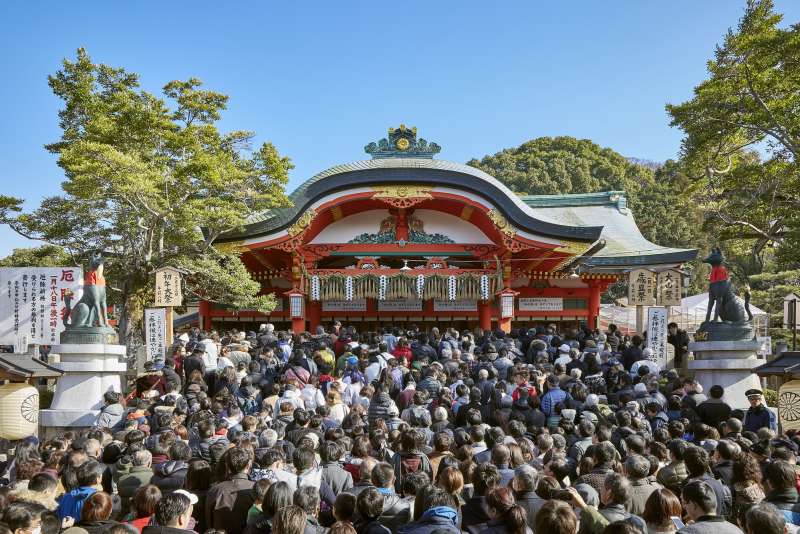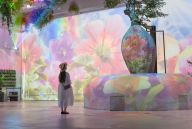Welcome the New Year at These 3 Kansai Area Shrines

In Japan, various festivals that have a long history and traditions handed down from generation to generation are held throughout the year. One of the largest winter events is the New Year holiday.
Here are three spots in the Kansai area that are popular for the first shrine visit during the New Year. All of these spots are well-known tourist attractions, so why not add them as to-go places on your next itinerary? There are some rules and etiquette to follow when visiting shrines, so do check them before your visit.
(1)Over 200,000 worshipers in the first 3 days: Sumiyoshi Taisha, Osaka

If you are going to stay in the Kansai area, we recommend visiting Sumiyoshi Taisha, the head shrine of Sumiyoshi shrines nationwide. Worshipers come here to seek good luck, a safe baby delivery, business prosperity, and traffic safety.
At midnight on January 1, when the New Year officially starts, the area comes alive. The sounds of taiko drums beating and the applause of the attendees fill the air. On this day, the shrine is packed with people who pray for happiness and good luck for the new year.
Alongside the first shrine visit of the year are many special events. Shiwasu Oharaishiki (December Purification Ritual) and Joyasai (New Year’s Eve Festival) are held at 5 p.m. on December 31 to erase the sins and impurities of the outgoing year. In the early morning of January 1, the priest puts the first water pumped from the divine well into a bamboo tube and offers it to the gods in the Wakamizu Ceremony. On January 4, the Toka Shinto Ritual is held, and on the 7th, people observe the Aouma Shinji (Ritual of the White Horse).
In this ritual, the divine horse is led around the main shrine. It is said that seeing the white horse at the beginning of the year wards off evil spirits. Also a must-see is the main shrine of Sumiyoshi-zukuri, which was constructed in 1810. It is designated as a natural treasure as it has one of the oldest shrine architecture styles in history.

Address: 2-9-89 Sumiyoshi, Sumiyoshi-ku, Osaka
New Year Schedule: Shiwasu Oharaishiki Ceremony / Joyasai Festival: December 31, 5 p.m.~ Wakamizu Ceremony: January 1, 5 p.m.~
New Year's Day: 6 p.m.~
Access: About 3 minutes on foot going east from Sumiyoshi Taisha Station on the Nankai Main Line
(2)O-Inari-san with a history of over 1,300 years: Fushimi Inari Taisha, Kyoto

Fushimi Inari Taisha is the head shrine of all Inari shrines, of which there are 30,000 in Japan. On December 31 at 3 p.m., worshipers observe Oharaeshiki, a ritual to cleanse them of their sins. This is followed by the Joyasai Festival, which thanks the guardians of Inari Okami for a safe end to the year. On January 1 at 6 a.m., revelers ring in the Saitansai Festival to celebrate the New Year and pray for peace to prevail. It’s held at the main shrine and is attended by thousands. Be sure not to miss the main shrine, which has been designated as an Important Cultural Property, and the vermilion-colored tower gate, which is said to have been donated by the famous Japanese ruler Toyotomi Hideyoshi in 1589. As you approach the shrine, note the stalls selling quail yakitori, sparrow yakitori (during winter only), and Inari Senbei (rice crackers) made with fragrant roasted sesame seeds. Kitsune Senbei, a rice cracker with a fox motif, is also a popular souvenir.
Location: 68 Fukakusa Yabunouchi-cho, Fushimi-ku, Kyoto
Event Date: Oharaeshiki Ritual: December 31, 3 p.m.〜
Saitan Festival: January 1, 6 a.m.〜
(Please check the official website for the latest schedules and information.)
Access: A short walk from Inari Station on the JR Nara Line
(3) Pray to pass exams and for the safety of your family in the New Year: Kitano Tenmangu, Kyoto

Kitano Tenmangu, the head shrine of the 12,000 Tenmangu and Tenjinsha shrines nationwide, enshrines the god of learning and cultural entertainment, Sugawara no Michizane. This makes it a famous worshiping spot among students taking entrance exams and exams for qualifications.
The shrine hosts many events during the New Year holidays. On December 31, an Oharae (purification) ritual uses katashiro (paper dolls) in a ceremony where filth of the mind and body are entrusted to the dolls to cleanse one of sins and injuries. A Joyasai is held in gratitude for the year that is about to end and to pray for peace in the new year.
In the evening, it’s time for the traditional ritual Hinawa Juyo. A slow match is lit with a purification fire, and if the fire is used to cook New Year meals such as ozoni (mochi soup), you can spend a year without illness. On the first day of the new year, the Saitansai Festival is also held, and more than 700,000 people visit to pray for passing examinations and for the safety of the family.
Be sure not to miss the Gohonden, a national treasure of Momoyama architecture situated in the shrine precincts. It is also recommended to stroke the head of the nade ushi (rubbing ox) statue, which is believed to make you smarter.
Kyoto is famous for tofu skin and delicious pickles, and there are lots of Japanese restaurants in the area around Tenmangu. Why not drop by for lunch or a break before or after your shrine visit?
Location: Kitano Tenmangu Office, Kamigyo-ku, Kyoto
Event Dates: New Year's Eve ritual: December 31; Saitansai Festival, January 1 (Please check the official website for the latest schedules and information.)
Access: Take the City Bus 50 or 101 from JR Kyoto Station to Kitano Tenmangu-mae Bus Stop and it’s right by the bus stop
Refer to the following for more information on the facilities mentioned in this article
Kansai
https://www.japan.travel/en/destinations/kansai/
Osaka
https://www.japan.travel/en/destinations/kansai/osaka/
https://www.japan.travel/en/travel-directory/Osaka/
http://www.kyototourism.org/en/
Kyoto
https://www.japan.travel/en/destinations/kansai/kyoto/
https://www.japan.travel/en/travel-directory/Kyoto/
http://www.kyototourism.org/en/
Don’t miss out! 3 Convenient Passes for Going Around the Kansai region
https://www.japan.travel/en/my/enjoy-smart-trip-travel-passes/dont-miss-out-3-convenient-passes-going-around-kansai-region/
Sumiyoshi Taisha:
http://www.sumiyoshitaisha.net/en/
Fushimi Inari Taisha:
http://inari.jp/en/
Kitano Tenmangu:
https://kitanotenmangu.or.jp/top_en.php




























































